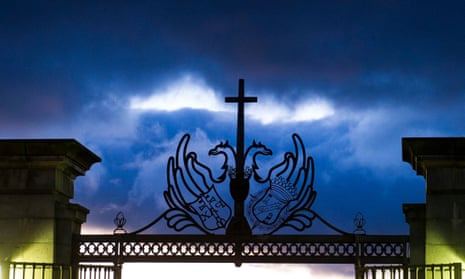Briefly, fog threatened to disrupt General Francisco Franco’s final, unscheduled journey . Then the sky cleared and a helicopter was able to carry the dictator’s coffin away from the Valley of the Fallen, Europe’s most unloved war memorial. After 16 months of wrangling over Franco’s exhumation, the ceremonies of departure were performed with a dignity not accorded to the 100,000 victims of Spain’s 1936-39 civil war who still lie in unmarked graves. A reburial was performed in a private ceremony at the family mausoleum north of Madrid, where Franco now lies next to his wife, Carmen.
This symbolic settling of accounts with a dead dictator might have seemed a touch macabre, but it was necessary. Spain’s socialist prime minister, Pedro Sánchez, was correct to say the country had fulfilled a duty to itself by removing Franco from the triumphalist, overbearing memorial he created as “a national monument of atonement”, after the civil war. The Valley of the Fallen, with its basilica and 150m high cross, was built in 1940 in part by the forced labour of an estimated 20,000 political prisoners. It contains almost 34,000 corpses, including thousands of Franco’s republican victims, interred there en masse without permission and inaccessible to relatives. With Franco buried at its heart after his death in 1975, it became a nationalist shrine, and focus of nostalgia for the far right; a monument to division rather than reconciliation.
In a televised address on Thursday, Mr Sánchez said: “Modern Spain is the product of forgiveness, but it cannot be the product of forgetfulness. A public tribute to a dictator was more than an anachronism. It was an affront to our democracy.” Inevitably, there were protests, from left as well as right. Government ministers were criticised by the United Left party for attending the exhumation ceremony. In Madrid, socialist memorials were daubed with graffiti. The proximity of Spain’s general election, due on 10 November, led to charges that Mr Sánchez was playing “necro politics” and trying to distract attention from the Catalan crisis. But in tone and intent, Thursday was a well-judged handling of a delicate but necessary moment.
For years, Spain struggled to find the right balance between remembering and forgetting the Franco era. Much of Europe had to confront awful truths in the aftermath of the second world war. France took decades to take its share of responsibility for the infamous Vel’ d’hiv roundup, when French police detained 13,000 Parisian Jews in a velodrome prior to deportation. But Spain’s problems were unique. The country remained neutral during the great conflagration and, under Franco’s long dictatorship, the losing side in its own vicious civil war was obliged to remain silent in order to survive.
After the dictator’s death, the embrace of democracy was swift, bloodless and more or less uncontested, barring a quixotic attempted military coup in 1981. Yet it turned out that moving on from Franco at such speed required a kind of amnesia. As Spain modernised, joined the EEC and became a bastion of liberal democracy, there was little appetite for looking back. The so-called pact of forgetting was promoted as a peaceful solution to the problem of the past and the approach had a psychological realism to it. Silence permitted a breathing space in which a new civil society could begin to take shape. But it was not indefinitely sustainable.
By the 2000s, a memory movement was being driven by younger generations less fearful of reopening wounds. There was a hunger to know the truth about the lives (and whereabouts) of grandparents and great-grandparents. The Historical Memory Law was passed in 2007, enabling assistance to be offered to surviving victims of Franco’s dictatorship and their families. Thursday’s exhumation and reburial of Franco was a welcome landmark moment in that process.
Spain’s deputy prime minister, Carmen Calvo, has pledged that the work to recover and identify the bodies of Franco’s victims will go on. As a nationalist resurgence swells across much of Europe, sometimes drawing dark lessons from the past, Spain is becoming a kind of role model in how to remember.
